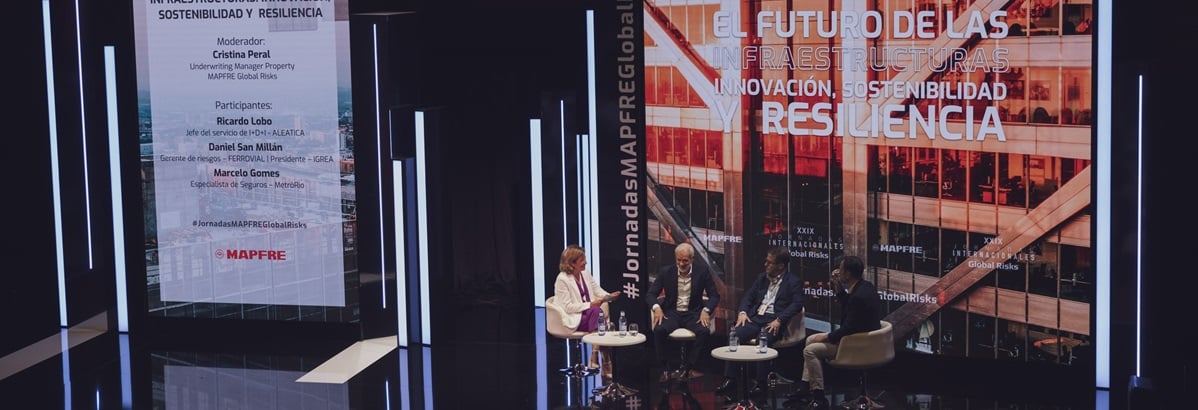Cristina Leon Vera | 02/10/2024
The infrastructure industry is undergoing an unprecedented transformation, driven by technological advances, climate urgency, and growing social demands. But how are industry experts addressing these challenges?
To unpack this interesting debate, the 29th International Global Risks Seminar, organized by MAPFRE, hosted an engaging talk moderated by Cristina Peral, Head of Underwriting of the Damages Department for MAPFRE Global Risks. At the Seminar, we had the opportunity to listen to Ricardo Lobo, Head of the R&D&I Service for Aleatica; Daniel San Millán, Risk Manager for Ferrovial and President of IGREA; and Marcelo Gomes da Silva, Insurance Specialist for MetrôRio.
The infrastructure industry has historically been a driver of economic and social development, promoting job creation, increasing productivity, and improving mobility. According to data from the World Bank, nearly $96 trillion in investment will be needed in infrastructure by 2040 to sustain global growth.
The United Nations, through its Sustainable Development Goal (SDG) number 9, has emphasized the importance of maintaining resilient, sustainable, and quality systems. This target is unavoidable if we plan to move towards truly sustainable development. In fact, 70% of carbon emissions are attributed to the construction and operation of infrastructure, highlighting the urgent need for transformation within the sector.
Innovation: key to the future of infrastructure
One of the pillars of this transformation is innovation. Ricardo Lobo emphasized the disruptive nature of the changes occurring in the sector by stating that “the traditional infrastructure landscape, built on concrete and steel, has evolved to demand versatile facilities that can adapt to the continuously emerging exponential changes.” For Aleatica, it’s not only about reducing environmental impact, but also about ensuring the sustainability of the business itself.
In this regard, Lobo referred to the need for connected infrastructures that are prepared to withstand technological disruptions, such as the deployment of autonomous and electric vehicles. A crucial aspect is electrification, where systems cannot be merely “chunks of concrete,” but must facilitate the transition to renewable energy and reduce dependence on fossil fuels.
Daniel San Millán presented an innovative example of dynamic toll roads in the United States. These intelligent facilities adjust their rates in real time based on various factors, with the primary factor being the speed differential between the toll lanes and the traditional lanes. San Millán clarified that users have found great value in this model, stating, “they even use toll roads when the traditional lanes are not congested because they prefer to travel faster and feel safer. They don’t mind paying for a service.”
However, he lamented that there are currently no projects in Europe that incorporate this toll system. “I believe it will come,” he asserted, “because alleviating congestion on the M-30 or M-40 would be a wonderful thing.”
Sustainability: an unavoidable challenge
Sustainability, in its environmental, social, and economic dimensions, was another key focus of the round table discussion. Marcelo Gomes da Silva, insurance specialist for MetrôRio, explained how the Rio de Janeiro subway, which transports 700,000 people daily, has integrated sustainability into its business strategy. “Our purpose is to give back to society the benefits we obtain through infrastructure improvements, as well as through social inclusion and equity,” he affirmed.
One of the most notable examples is the contactless payment system implemented by the company, a technological advancement that not only simplifies users’ lives but also promotes social sustainability through partnerships with local businesses to support cultural and educational initiatives.
Additionally, the environmental component remains a top priority. The electrification of transport and decarbonization are essential steps in this case. According to Ricardo Lobo, “electric vehicles represent a crucial commitment to the decarbonization of the transport sector, and our infrastructure must be adapted to support their widespread adoption.” In Aleatica, they have developed an inductive charging system for electric vehicles that allows for charging while in motion, an innovation that could transform the concept of autonomy in electric cars.
Resilience: preparing for climate change
Climate change is a reality that directly impacts infrastructure, making resilience a top priority in its design and maintenance. Daniel San Millán shared the ADAPTARE project, developed by Ferrovial and the University of Cantabria, to assess the physical impact of climate change on their assets. This tool will make it possible to analyze climate risks and plan the necessary actions to build resilient infrastructure.
“The challenge lies not only in quantifying the impact on costs and revenues but also in taking the necessary measures to ensure the long-term sustainability of our infrastructure,” revealed San Millán. The rising frequency and severity of extreme weather events, among other factors, underscore the need for systems that can effectively withstand these challenges.
 The role of the insurance sector
The role of the insurance sector
The insurance sector plays a crucial role in protecting infrastructure from risks that, while familiar, have evolved. Marcelo Gomes da Silva emphasized the importance of having the right insurance coverage to mitigate the risks associated with climate change. For MetrôRio, coverage for environmental risks is becoming an increasingly important priority, particularly in light of the floods triggered by heavy rains— a phenomenon that has impacted several Brazilian cities in recent years. Furthermore, Gomes da Silva stressed the need for robust cyber insurance to protect user data and ensure operational continuity. “Data security is critical to our image and to our customers’ trust,” he said.
San Millán seized the opportunity to urge the insurance sector to keep pace with innovation, ensuring it doesn’t fall behind in the evolution of infrastructure. Cyber and environmental insurance are increasingly in demand, as modern facilities are vulnerable not only to climate events but also to digital attacks. It’s crucial for the sector to adapt to these new realities, providing effective solutions to ensure asset protection.
Building a legacy
To conclude the panel, Cristina Peral invited the speakers to reflect on the legacy they hope to leave by the year 2100. Ricardo Lobo emphasized that true success lies in being remembered as good people and ensuring that innovation benefits society. Marcelo Gomes da Silva shared MetrôRio’s mission of “moving Río de Janeiro,” highlighting the importance of giving back to the community. Daniel San Millán expressed his wish to be remembered for his contributions to his community, underscoring that in a people-centered business, humanity and relationships are essential. A human-centered approach is key to a sustainable future.





